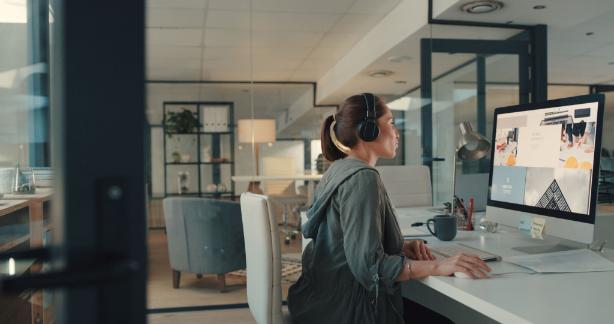The goal of visual design is to improve the overall look of a website and its collateral by selecting and arranging visual elements such as images, colours, and typefaces. A good visual design adds to the overall experience rather than detracting from it. As a matter of fact, it improves it by generating interest and trust in the brand among its target audience.
Basic Elements of Visual Design
The following are the primary building blocks from which elaborate designs are constructed:
- Lines are used to define shapes, make divisions, and generate textures by joining points together. If a line is straight, it will have dimensions: how long it is, how wide it is, and which way it points.
- Forms are discrete regions. The graphic artist uses lines, value contrasts, colour, and/or texture to demarcate the space. Shapes are the building blocks of everything.
- The selection and combination of colours in a palette can be used to set apart elements, develop a sense of depth, highlight key features, and even aid in the classification of data. Color theory is a branch of psychology that studies the emotional toll taken by a range of colour schemes.
- The term “texture” is used to describe the actual or perceived qualities of a surface. Texture and pattern can be made by repeatedly using the same element. Intentionally drawing or dissuading the viewer’s gaze is just one of the many strategic uses for textures.
- The selection of fonts as well as their sizing, positioning, colour, and spacing are all part of typography.
- Shape describes the volume and mass of three-dimensional objects. Combining shapes is one way to make a new form, and various tones, textures, and colours can further accentuate the result.
Principles for Creating a Visual Design
By following these guidelines, you can create a visually appealing design that cohesively incorporates the aforementioned elements. As you try to apply the fundamentals, bear in mind:
- The concept of unity refers to how well all of a page’s components fit together, both aesthetically and conceptually. Finding that sweet spot between too much uniformity and too much variety can be challenging for visual designers.
- In visual design, gestalt aids in understanding the whole rather than its parts. If everything is laid out correctly, the design’s Gestalt will be crystal clear.
- “Defined when something is placed in it,” writes Alex White in The Elements of Graphic Design. Making use of negative space in design can lessen background clutter, improve legibility, and even serve as a vehicle for optical illusion. Include white space as a key component of your design.
- The significance of different things can be compared using a hierarchy. Different font sizes, colours, and placement on the page are common ways in which designers establish hierarchies. Items near the top of a list are more likely to be considered crucial.
- Achieving a sense of equilibrium gives the impression of fairness. This does not necessarily imply symmetry.
- The goal of using contrast is to draw attention to something by highlighting its differences from its surroundings.
- By showing the relative sizes of various elements, scale adds dimension and interest to a presentation.
- Having one thing stand out while everything else takes a backseat is the essence of dominance. Size, colour, position, shape, etc., can all be used to create this effect.
- The term “similarity” refers to the practise of achieving visual cohesion in a design without resorting to carbon copies. Using similarities between interface components facilitates their interoperability and facilitates the rapid acquisition of interface expertise by end users.
Example of Pulling it all together
Putting together a page or an idea from scratch can be daunting, but applying design principles to the basic elements becomes second nature after a while. See some of these principles in action on an example homepage:
- The word “stop” was made more visible in the logo by using a contrasting colour scheme.
- The size and arrangement of text can establish a clear order.
- The featured image in the carousel acts as a visual anchor, drawing attention away from the secondary images below it.
- In order to give the page some breathing room, white space is used around the text and in between the different sections.
- The page’s text and images are set against a textured backdrop for enhanced readability.
- Scale-based map.
- Sectioning lines, or break lines.
- Templates for making buttons with these shapes.
Additional Information
- The Basics of Graphic Design by Alex White (2nd Edition).
- Here is an index of Jim Krause’s Design Fundamentals articles.
- The ‘Poppy Evans and Mark Thomas’ Taking a Look at the Building Blocks of Good Design.
- Disclaimer for Leaving the UX-Designed Website.
- Key Visual Design Ideas Warning before leaving the site.
- Interface Design and Visual Appeal Disclaimer for Leaving the Yellow Brick Road Website.
- The Elements of User Experience: User-Centered Design for the Web and Beyond by Jesse James Garrett (2nd Edition).


